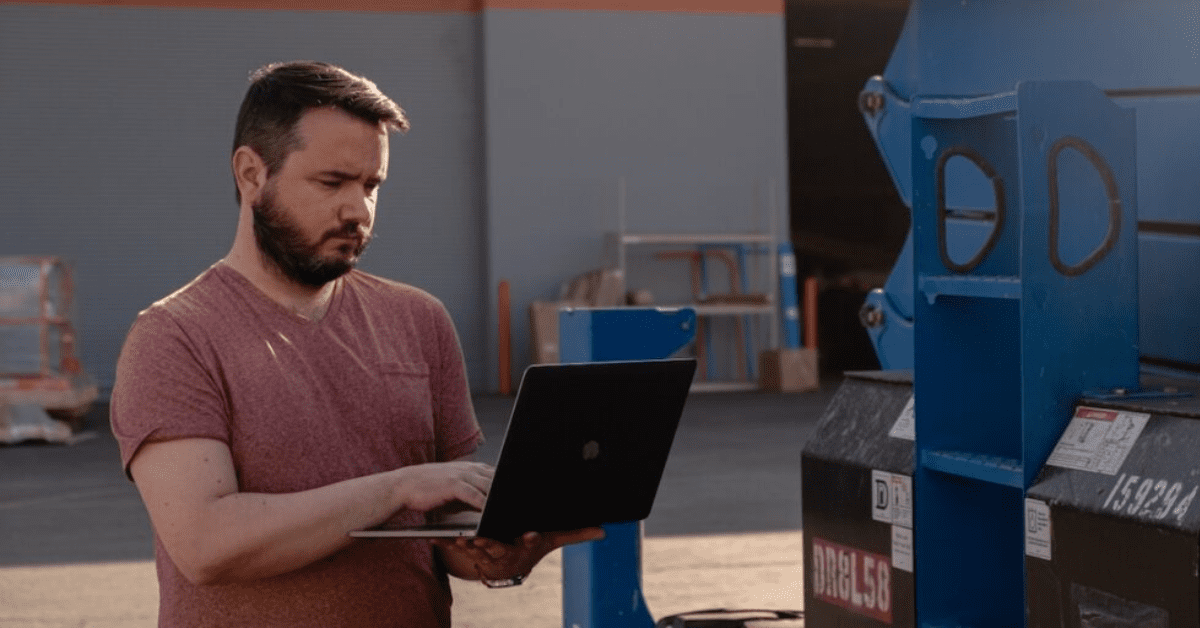

Telematics systems combine telecommunications and informatics, allowing for remote monitoring and control of a vehicle fleet. It uses GPS and other sensors to collect and transmit real-time data about a vehicle’s location, speed, and performance, giving fleet managers more oversight over their operations.
This data is typically sent to a central server or cloud platform and can be accessed and analyzed by the operator or fleet manager. Read more about telematics systems here.
Imagine a world where your vehicles could communicate and let you know when they need maintenance. Sound futuristic? Fortunately, the future is already here with the integration of telematics, a powerful technology that can help monitor and track everything from engine health to tire pressure and physical location.
Telematics is made possible by connecting directly to vehicles and is commonly used to track:
This data can then be used for multiple purposes, including tracking vehicle location and performance in real-time, diagnosing and troubleshooting vehicle issues, and calculating personalized insurance premiums based on an individual’s driving behavior.
Telematics has a rich history that spans over several decades, evolving in conjunction with advancements in communication and digital technologies. The concept initially emerged in the 1960s with the early development of vehicle tracking systems for military and logistics applications.
During the 1980s, the term “telematics” was formally introduced, stemming from the French “télématique,” a blend of telecommunications and informatics. This period saw the adoption of GPS technology and cellular communication, which laid the foundation for modern telematics.
The 1990s marked a significant era for telematics, with the commercial market beginning to recognize its potential. This decade witnessed the advent of more sophisticated vehicle navigation systems and the introduction of real-time data transmission.
The integration of telematics into passenger vehicles, spearheaded by companies like General Motors with their OnStar service, showcased how telematics could enhance driver safety and route efficiency.
In the 2000s, the rise of the internet and wireless communication further propelled the field, making telematics more accessible and practical for various industries, including construction and fleet management. The proliferation of mobile devices and cloud computing transformed telematics from simple tracking and navigation to comprehensive asset management solutions.
Today, telematics has become an integral part of fleet management, empowering businesses with real-time data analytics, predictive maintenance, and improved operational efficiencies. Its continuous evolution promises even more innovative applications, driven by advancements in IoT, AI, and machine learning.
The journey of telematics from its military roots to a pivotal role in modern industry highlights its tremendous impact and potential for future growth.
Trackunit provides telematics technology for construction companies
So, how does it work? Telematics systems are made up of a few components including a hardware device and sensors that collect vehicle or machine data and transmit this information to a centralized server or cloud where it’s accessible via an easy-to-understand platform.
Connected via the CAN, a communication protocol that facilitates real-time data collection, or the OBD II port, telematics can use these sensors to relay in-depth information from onboard diagnostics about the status of each vehicle in a fleet.
Devices often include the following hardware components:
The sensors and hardware can collect various types of data, such as:
Open-platform telematics systems are versatile solutions that integrate seamlessly with various hardware and software components, offering unparalleled flexibility and scalability for construction fleet management.
Unlike proprietary telematics systems that lock users into specific vendors’ ecosystems, open-platform systems are designed to support a wide array of third-party applications and devices. This interoperability allows fleet managers to tailor their telematics setup to meet unique operational needs, from integrating advanced fuel monitoring systems to adopting cutting-edge predictive maintenance tools.
Open-platform telematics systems hold significant importance for construction fleet management for several reasons. Firstly, they enable a holistic view of fleet operations by aggregating data from multiple sources, leading to more comprehensive and actionable insights.
Secondly, their adaptability ensures that the telematics infrastructure can evolve alongside technological advancements, thus future-proofing the investment.
Lastly, the ability to customize and expand the system according to specific requirements enhances operational efficiency, reduces downtime, and ultimately contributes to cost savings. By embracing open-platform telematics, construction companies can foster innovation, improve decision-making, and maintain a competitive edge in an ever-evolving industry.

Fleet telematics systems are commonly used in fleet management software, vehicle tracking and diagnostics, and fleet maintenance applications. They can provide significant benefits, including improved efficiency, safety, and cost savings.
Fleet telematics systems can include a wide range of features. The most common features of vehicle telematics include the following:
GPS tracking
Fleet telematics systems can use GPS to track the location of fleet vehicles in real time for operational efficiency and asset security. This data can be used to optimize routes and reduce travel time and fuel consumption.
Location tracking also allows for the immediate identification of unauthorized vehicle usage. Geofencing, for example, can send real-time alerts when machines move beyond a designated zone. Precise tracking helps managers and authorities quickly recover stolen assets.
Vehicle diagnostics
Fleet telematics systems often include sensors that monitor various aspects of a vehicle’s performance, including engine temperature, tire pressure, and fuel consumption.
This real-time diagnostic data allows fleet managers to identify, address and troubleshoot potential issues before they escalate, reducing the risks of costly repairs and unplanned downtime. Proactive maintenance scheduling based on this data also extends the lifespan of the vehicles.
Driver monitoring
These systems can include sensors that monitor driver behavior, such as speeding, sudden acceleration or braking, and seatbelt use. This data can be used to improve driver safety and identify unsafe driving and operating practices.
Fleet managers can use this data to evaluate their operators’ skill levels and create customized training if and where needed. Safer driving and operational practices can improve fleet safety, lower insurance costs and decrease the risk of accidents.
Communication capabilities
Systems may include messaging and hands-free calling, which can help improve communication between drivers, dispatchers, or fleet managers.
Integration with other systems
Some systems offer seamless integrations with various other management tools, such as fuel management, maintenance scheduling, and dispatch systems. These integrations provide fleet managers with a more comprehensive overview of their fleet operations, helping them make better decisions.
Consolidating data from multiple sources into a single platform helps streamline processes, improve accuracy, and foster a more strategic approach to fleet management.
Overall, the features of a fleet telematics system will depend on your company’s specific needs, goals, and the types of assets you want to monitor.
Fleet telematics is a game-changer in fleet management. Fleet managers have a lot on their plate, as they’re responsible for overseeing and managing the various costs, health, and regulatory requirements of a company’s fleet.
Fleet telematics systems provide numerous benefits that can streamline and enhance fleet operations from acquisition and maintenance to the eventual disposal of vehicles:
Lower premiums: How telematics impacts insurance
Telematics provides comprehensive, precise data on vehicle usage, driver behavior, and maintenance history. With detailed and precise maintenance history, usage, accident patterns, and driving habit data, insurers can accurately assess risk and potentially reduce premiums for fleets demonstrating safe practices.
Equipment theft is a major issue for the construction industry due to rising costs. Fortunately, real-time equipment monitoring makes it easier to ensure high-value assets stay on site, and location tracking increases recovery rates. Many equipment insurers offer discounts and enhanced coverage for integrating these preventative technologies into your fleet management strategy.
Companies can experience better fleet connectivity, increased productivity, and simplified management by implementing a telematics solution for their fleet.
Automotive telematics devices are not difficult to install, but they do require some level of knowledge, especially for more complex fleets like construction and off-road equipment. You can either have it professionally done or follow the manufacturer’s instructions in-house. Consider your fleet to decide which option will be best for your company.
To install the device:
Some companies allow you to demo their product before you settle in to purchase it. Here at Trackunit, we encourage potential clients to take advantage of the trial period to see if our telematics system works for your business and equipment.
The cost of a telematics system can vary based on several factors, from the size of your fleet to the cost of actual hardware and the number of features a software platform offers.
Here are our top five factors affecting the price:
These are just a few components that can influence your final bill. It’s important to note that specific pricing can also vary based on the telematics provider, training and support, and geographic coverage.
At Trackunit, we tailor a specific pricing plan based on each of our client’s needs. For an accurate estimate for your fleet, visit our pricing page to see your options or contact our team to get a quote.
The future of fleet telematics is poised to be marked by continued technological innovation and integration with emerging technologies. As the Internet of Things (IoT) expands, telematics systems will become even more interconnected, enabling real-time communication between vehicles, infrastructure, and management systems. The advent of 5G technology will enhance data transmission speeds and reliability, allowing for more instantaneous and precise data analytics.

Artificial intelligence (AI) and machine learning (ML) will play a significant role in predictive analytics, helping to foresee maintenance needs, optimize routes, and identify patterns that contribute to improved operational efficiency and safety. Autonomous vehicles, while still in development, will eventually be integrated with telematics systems, allowing for more sophisticated fleet management and operational automation.
Environmental sustainability will become an increasingly important focus. Telematics will help fleets transition to electric and hybrid vehicles by providing critical data on battery life, charging infrastructure, and energy consumption patterns. This shift will not only reduce carbon footprints but also lead to significant cost savings over time.
In essence, the future of fleet telematics will be characterized by enhanced connectivity, smarter analytics, greater automation, and a stronger emphasis on sustainability. These advancements will further empower fleet managers to make data-driven decisions, improve operational efficiency, and maintain a competitive advantage in an ever-evolving industry.
At Trackunit, we offer telematics solutions for the construction industry. Our telematics system is designed to help companies improve efficiency, reduce costs, and enhance safety by monitoring their vehicles and equipment in real-time.
Our telematics devices include various features, such as GPS tracking, vehicle diagnostics, driver monitoring, and communication capabilities. We also offer a cloud-based platform that allows users to easily access and analyze data collected by our telematics systems and generate reports and alerts.
To find out more about how our solutions can improve your fleet management processes, request a demo here.
As mentioned earlier, fleet telematics is used extensively to enhance various aspects of fleet management by leveraging real-time data collection and analysis. Telematics aids in tracking vehicle location, monitoring driver behavior, and optimizing route planning. The software also plays a crucial role in predictive maintenance, allowing for timely repairs and maintenance scheduling based on actual usage and diagnostics data.
Telematics and GPS are often conflated; however, while telematics can incorporate GPS features, they are different. GPS only provides location data, but telematics offers more in-depth information like real-time engine diagnostics, usage insights, and location information.
Most modern vehicles will have some level of telematics technology embedded for GPS and engine diagnostics features. However, more complex telematics systems can also be used for everything from off-road construction vehicles and heavy machinery to commercial delivery trucks.
The sophisticated technology of internal sensors allows telematics systems to be incredibly accurate. They are usually able to provide location within 10 to 50 feet.
Here’s a list of examples of industries that use telematics to unify their fleets and improve their fleet management:
For most modern vehicles, it’s not possible to fully shut off a telematics system on your own. To do so, you’ll likely need to reach out to the telematics provider.
Telematics systems have many benefits, but they do come with potential challenges.
Some of the challenges can include the initial learning curve and training required for team members, increased premiums for riskier driving practices and, without the right system, large volumes of data may be difficult to decipher.
To mitigate these issues, Trackunit offers a product demo and excellent customer support. Our centralized software is a simple virtual dashboard, making it easy to access your fleet data on a smart device or tablet.
Telematics in IoT refers to the integration of telecommunication systems, vehicle technologies, and information technology within the Internet of Things framework. This convergence allows for sophisticated data exchange and connectivity between vehicles and other IoT-enabled devices.
By leveraging IoT, telematics systems can facilitate real-time monitoring of vehicle parameters, enhance predictive maintenance, and optimize routing through advanced data analytics. The interconnectivity enabled by IoT extends the capabilities of traditional telematics, providing a more comprehensive and efficient approach to managing fleets and other vehicular assets.
Trackunit stands out as the premier choice for companies seeking top-tier fleet management software, particularly in the construction industry. Renowned for its cutting-edge telematics technology, Trackunit delivers unparalleled insights and control over fleet operations.
One of the key reasons for Trackunit’s superiority is its open-platform approach, which allows seamless integration with a diverse range of hardware and software. This flexibility ensures that construction companies can tailor the system to their unique operational needs, enhancing both efficiency and adaptability.
Another critical advantage of Trackunit is its focus on real-time data analytics. By providing immediate insights into vehicle location, driver behavior, fuel consumption, and predictive maintenance, Trackunit empowers fleet managers to make informed decisions that optimize performance and reduce downtime.
The intuitive dashboard and user-friendly applications make it easy to access and interpret this data, enabling proactive management of assets and resources.
Want to learn more about how to bring every asset into view with Trackunit’s rugged telematics devices and connected network? Fill out the form here, and we’ll get back to you soon.

